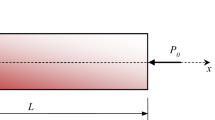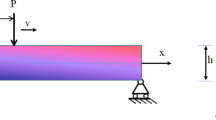The bending vibration of a functionally graded Euler–Bernoulli beam is investigated by the transformed-section method. The material properties of the functionally graded beam (FGB) are assumed to vary across its thickness according to a simple power law. Closed-form solutions for free vibration frequencies of FGBs with classical boundary conditions are derived. Some analytical results are compared with numerical results found in the published literature to verify the accuracy of the model presented, and a good agreement between them is observed.






Similar content being viewed by others

References
S. Suresh, “Modeling and design of multi-layered and graded materials,” Prog. Mater. Sci., 42, 243-251 (1997).
Y. Miyamoto, W. A. Kaysser and B. H. Rabin, Functionally Graded Materials: Design, Processing and Applications, Dordrecht, Kluwer Academic Publishers (1999).
V. Birman and L. W. Byrd, “Modeling and analysis of functionally graded materials and structures,” Appl. Mech. Rev., 60, 195-216 (2007).
M. Aydogdu and V. Taskin, “Free vibration analysis of functionally graded beams with simply supported edges,” Mat. Des., 28, 1651-1656 (2007).
X. F. Li, “A unified approach for analyzing static and dynamic behaviors of functionally graded Timoshenko and Euler-Bernoulli beams,” J. Sound Vib., 318, 1210-1229 (2008).
S. Sina, H. M. Navazi and H. Haddadpour, “An analytical method for free vibration analysis of functionally graded beams,” Mat. Des., 30, 741-747 (2009).
M. T. Piovan and R. Sampaio, “A study on the dynamics of rotating beams with functionally graded properties,” J. Sound Vib., 327, 134–143 (2009).
M. Simsek, “Vibration analysis of a functionally graded beam under a moving mass by using different beam theories,” Compos. Struct., 92, 904-917 (2010).
M. Simsek, “Fundamental frequency analysis of functionally graded beams by using different higher-order beam theories,” Nucl. Eng. Des., 240, 697-705 (2010).
A. E. Alshorbagy, M. A. Eltaher and F. F. Mahmoud, “Free vibration characteristics of a functionally graded beam by finite element method,” Appl. Math. Mod., 35, 412-425 (2011).
S. C. Mohanty, R. R. Dash, and T. Rout, “Parametric instability of a functionally graded Timoshenko beam on Winkler’s foundation,” Nucl. Eng. Des., 241, 2698-2715 (2011).
K. S. Anandrao, R. K. Gupta, P. Ramachandran, and G. V. Rao, “Free vibration analysis of functionally graded beams,” Def. Sci. J., 62, 139-146 (2012).
H. T. Thai and T. P. Vo, “Bending and free vibration of functionally graded beams using various higher-order shear deformation beam theories,” Int. J. Mech. Sci., 62, 57–66 (2012).
N. Wattanasakulpong and V. Ungbhakorn, “Free vibration analysis of functionally graded beams with general elastically end constraints by DTM,” World J. Mech., 2, 297-310 (2102).
H. Su, J. R. Banerjee, and C. W. Cheung, “Dynamic stiffness formulation and free vibration analysis of functionally graded beams,” Compos. Struct., 106, 854–862 (2013).
T. K. Nguyen, T. P. Vo, and H. T. Thai, “Static and free vibration of axially loaded functionally graded beams based on the first-order shear deformation theory,” Compos.: Part B, 55, 147–157 (2013).
K. K. Pradhan and S. Chakraverty, “Free vibration of Euler and Timoshenko functionally graded beams by Rayleigh-Ritz method,” Compos.: Part B, 51, 175-184 (2013).
K. K. Pradhan and S. Chakraverty, “Effects of different shear deformation theories on free vibration of functionally graded beams,” Int. J. Mech. Sci., 82, 149-160 (2014).
M. Aydogdu, “Semi-inverse method for vibration and buckling of axially functionally graded beams,” J. Reinf. Plast. Compos., 27, 683-691 (2008).
Y. Huang and X. F. Li, “Bending and vibration of circular cylindrical beams with arbitrary radial non-homogeneity,” Int. J. Mech. Sci., 52, 595-601 (2010).
J. Murin, M. Aminbaghai, and V. Kutis, “Exact solution of the bending vibration problem of FGM beams with variation of material properties,” Eng. Struct., 32, 1631-1640 (2010).
A. Shahba, R. Attarnejad, and M. T. Marvi, “Free vibration and stability analysis of axially functionally graded tapered Timoshenko beams with classic and non-classical boundary conditions,” Compos.: Part B, 42, 801-808 (2011).
X. F. Li, Y. A. Kang, and J. X. Wu, “Exact frequency equations of free vibration of exponentially functionally graded beams,” Appl. Acoust., 74, 413–420 (2013).
M. Aminbaghai, J. Murin, and V. Kutis, “Modal analysis of the FGM-beams with continuous transversal symmetric and longitudinal variation of material properties with effect of large axial force,” Eng. Struct., 34, 314-329 (2012).
J. Murin, M. Aminbaghai, V. Kutis, and J. Hrabovsky, “Modal analysis of the FGM beams with effect of axial force under longitudinal variable elastic Winkler foundation,” Eng. Struct., 49, 234-247 (2013).
J. Murin, M. Aminbaghai, J. Hrabovsky, V. Kutis, and St. Kugler, “Modal analysis of the FGM beams with effect of the shear correction function,” Compos.: Part B, 45, 1575–1582 (2013).
J. Murin, M. Aminbaghai, J. Hrabovsky, V. Kutis, J. Paulech, and S. Kugler, “A new 3D FGM beam finite element for modal analysis,” Proceedings of the 11th world congress on computational mechanics (WCCM XI), 5th European conference on computational mechanics (ECCM V), 6th European conference on computational fluid dynamics (ECFD VI). Barcelona, Spain (2014).
A. C. Ugural, Mechanical Design: An Integrated Approach, Singapore, McGrow-Hill Company (2004).
W. Weaver, S. P. Timoshenko, and D. H. Young, Vibration Problems in Engineering, 5th ed., John Wiley & Sons, Inc. (1990).
S. S. Rao, Mechanical Vibrations, 3rd ed., Addison-Wesley Publishing Company (1995).
L. Meirovitch, Fundamentals of Vibrations, International Edition, McGraw-Hill (2001).
S. B. Coşkun, M. T. Atay, and B. Öztürk, “Transverse vibration analysis of Euler-Bernoulli beams using analytical approximate techniques,” Advances in Vibration Analysis Research, Dr. Farzad Ebrahimi (Ed.), ISBN: 978-953-307-209-8, InTech (2011).
M. Simsek and T. Kocatürk, “Free and forced vibration of a functionally graded beam subjected to a concentrated moving harmonic load,” Compos. Struct., 90, 465-473 (2009).
S. Natarajan, P. M. Baiz, S. Bordas, T. Rabczuk, and P. Kerfriden, “Natural frequencies of cracked functionally graded material plates by the extended finite element method,” Compos. Struct., 93, 3082-3092 (2011).
X. Zhao and K. M. Liew, “Free vibration analysis of functionally graded conical shell panels by a meshless method,” Compos. Struct., 93, 649-664 (2011).
Author information
Authors and Affiliations
Corresponding author
Additional information
Russian translation published in Mekhanika Kompozitnykh Materialov, Vol. 53, No. 1, pp. 119-142 , January-February, 2017.
Appendix A
Appendix A
Based on the transformed-section method, the effective second moment of area of the transformed cross section of beams about their neutral axis is given as
Introducing z 1 = z − h o into Eq. (A1) yields
The quantities I y and A t are calculated as follows:
Inserting Eq. (5) into Eqs. (A3) and (A4) and performing integration, it is found that
Using Eqs. (A5), (A6) and (6) in Eq. (A2), the effective second area moment about the neutral axis of the transformed cross section of a functionally graded beam is obtained in the form
Rights and permissions
About this article
Cite this article
Chen, W.R., Chang, H. Closed-Form Solutions for Free Vibration Frequencies of Functionally Graded Euler-Bernoulli Beams. Mech Compos Mater 53, 79–98 (2017). https://doi.org/10.1007/s11029-017-9642-3
Received:
Revised:
Published:
Issue Date:
DOI: https://doi.org/10.1007/s11029-017-9642-3



